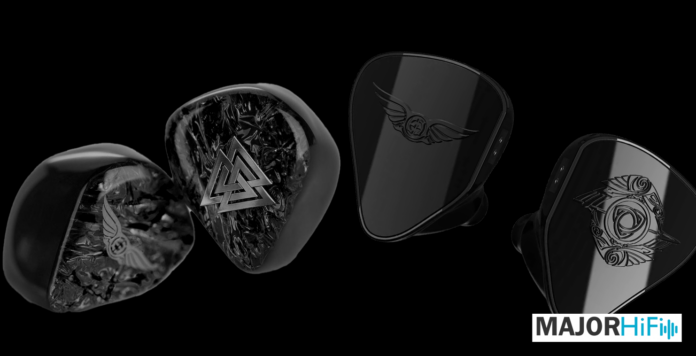Empire Ears has a ton of heavy hitters in its library of premium IEMs. One of these heavy hitters includes the Odin, which is one of my favorite IEMs around. Recently, Empire Ears launched its closest competitor: the Raven. The Raven has the same price and similar components, but how exactly do these two behemoths compare to each other?
What You Get
| Odin | Raven |
|
|
Look & Feel
There’s a launch edition and a standard edition for the Raven that changes its front plate. The Odin only has one version and it’s one of my favorite designs for an IEM. It’s immediately striking, with flashy colors that symbolize the Odin’s Bifrost theme. The Raven looks a bit plain in comparison, but its appearance might not matter as much to you. What’s going to be a bigger concern is the size of these shells. The Odin is considered a big shell, but the Raven is even bigger. Overall I felt more comfortable wearing the Odin for long periods compared to the Raven. The Raven didn’t cause too much pressure, but the seal did start to come loose a bit.
Design
Both IEMs have complex driver configurations that contain similar technology. The Odin has an 11-driver design, while the Raven features 12. They both contain balanced armatures, electrostatic, and custom W9+ dynamic drivers. The synX crossover network also features in both IEMs. A.R.C dampeners and EIVEC phase control for the bone conductor drivers also make an appearance in both IEMs, but the Raven features an upgraded version of EIVEC.
Soundstage
I still think the Odin is one of the best soundstages you can get over IEMs, but the Raven is very close. Both of these IEMs have incredible spatial imaging and accuracy, communicating open spaces with relative ease. They exhibit great separation with precise positioning. On the Raven, it feels like the angle of certain instruments feels almost exact, while the Odin is more delicate and airy. There’s no lack of immersion on either pair of IEMs. They both show a scale that’s rare for IEMs to replicate, with the Raven representing the most realistic stereo field, and the Odin presenting the most holographic wrap-around in its layering. However, the Raven also has distinct holographic features, making it harder to nail down which one I prefer. If you care a lot about soundstage and imaging, you can’t go wrong either way.
Low End
Comparing the bass of these IEMs is almost equally as challenging as the soundstage, but I think the Raven has the Odin beat in a few key areas. The sub-bass is a main feature of both sound signatures, but the Raven surpasses its depth with more dynamic frequency content. You’ll get great impact and energy from both low ends, but the Raven supplies superior balance. It’s able to articulate finer details while offering a similar grounded texture to the Odin. Things start to change up a bit in the mid-bass through, where I think the Odin shows a bit more finesse than the more resonant Raven.
Mids
Both midrange profiles on the Odin and Raven feature a wealth of character. You’ll never miss out on a single artifact no matter which pair of IEMs you end up going with. These IEMs are very similar in timbre and I’m not sure I completely prefer one over the other. The low mids are certainly more pronounced on the Raven, while the Odin shows an accent in its upper mids that adds more of a definitive tick to certain notes. They’re both treated with incredible balance though, with elegant details that showcase their amazing resolution. Clarity is never an issue, no matter what you go with, but the Raven can be considered slightly darker. I don’t think the Raven’s intricacies can be summed up that way, but when switching back and forth it becomes a bit clearer.
Highs
This is where the Odin and Raven take their biggest divergence. Both IEMs have very different tones in the highs, with the Odin still being my personal favorite here. The Raven has a clear shimmer to it that coats a lot of the mid-treble but takes a bit of a dip from there. Female vocals have crisp accents, but that’s the most texture you’ll get from them. In comparison, the Odin is a lot more colorful, not only featuring tons of sparkle, but the top end sizzles and tapers off definitively. It has a flavorful glimmer that I find more intoxicating than the Raven’s simpler treble response.
Summary
I’ve done a lot of these comparisons, and this is one of the closer ones. The Odin is one of my favorite IEMs, and it’s going up against basically the most updated version of it. However, they are still very different in a couple of areas, especially their builds. When it comes to their sound signatures, the Odin and Raven are very similar. I prefer the highs on the Odin, and the mids feel more clean all the way through. The Raven still delivers a lot of detail in both areas, just with a different flavor. Where the Raven excels the most over the Odin is in the bass, where the Raven enacts richer sub-bass frequencies. With their soundstages being too close to call, I can’t imagine a scenario where one is objectively better than the other. For the same price, you can’t go wrong no matter what you choose, but I think the Odin still holds the place as my favorite.
The Empire Ears Odin and Raven are available at Audio46.
Compare the ranking of various headphones, earbuds and in-ear monitors using our tools.
Discuss this, and much more, over on our forum.
---MAJORHIFI may receive commissions from retail offers.















